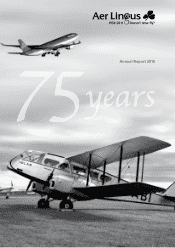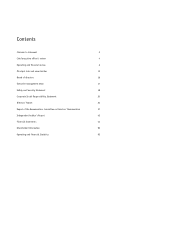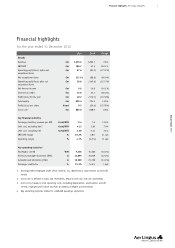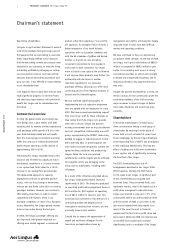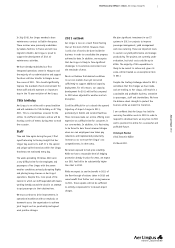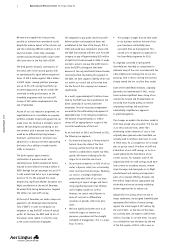Aer Lingus 2010 Annual Report Download - page 10
Download and view the complete annual report
Please find page 10 of the 2010 Aer Lingus annual report below. You can navigate through the pages in the report by either clicking on the pages listed below, or by using the keyword search tool below to find specific information within the annual report.
8
Annual Report 2010
Operating and fi nancial review Aer Lingus Group Plc
We were encouraged that it was proving
possible to achieve these operational results
despite the adverse impact of the volcanic ash
and the continuing diffi cult conditions in the
key Irish market. At the time, passenger
numbers passing through Dublin airport were
16% lower than in the fi rst half of 2009.
The third quarter showed a continuation of
the trends seen in the second quarter, with
an operating profi t, again before exceptional
items, of €79.2 million against €58.5 million
in 2009. Again, average yield per passenger
was up 12.5% with average load factor up
3.0 percentage points at 83.4% overall. We
continued to make good progress on the
Greenfi eld programme with run-rate staff
savings of €39 million implemented at the
end of September.
As part of our cost reduction programme, we
negotiated terms to consolidate our property
portfolio at Dublin Airport and agreed that we
would move into Terminal 2 at Dublin, when it
opened. We had delayed committing to the
new terminal until it became clear that there
would be no differential pricing between
Terminal 1 and Terminal 2. Terminal 2 was
attractive to us because we were approaching
the limits of our ability to handle transfer
traffi c in Terminal 1.
The fourth quarter again showed a
continuation of previous trends, with
operating losses (before exceptional items)
reduced to €2.6 million from €46.6 million in
2009. Average fare per passenger was up 19.0
% with overall load factor up 1.4 percentage
points at 72.7%. We achieved this result
despite very signifi cant weather disruption and
fl ight cancellations at the end of December.
We ended 2010 having delivered our targeted
€50 million run-rate staff savings.
At the end of December, we made a lump-sum
payment to the Employee Share Ownership
Trust (“ESOT”) in order to extinguish our
obligation to pay the ESOT a share of annual
profi ts. At the time, the ESOT held 12.5% of
the Group’s share capital, in trust for some
4,700 current and former employees.
The obligation to pay profi t share from profi t
before taxation and exceptional items was
established at the time of the Group’s IPO in
2006 and would have remained in place until
the ESOT had received suffi cient cash from the
company to pay off approximately €25 million
of debt that it had borrowed in 2006. It made
economic sense to pre-pay the profi t share to
allow the ESOT to extinguish their debt
because of the very substantial interest burden
incurred by them. By making this payment to
the ESOT, we have capped a liability which was
not within our control and at the same time
the free fl oat of the company has increased
signifi cantly.
As a result, approximately 62.5 million shares
held by the ESOT have now transferred to the
direct ownership of current and former
employees. Once all necessary arrangements
are made for the withholding and payment of
applicable taxes in the relevant jurisdictions,
the balance of approximately 4.1 million
shares will be appropriated in respect of the
non-Irish benefi ciaries of the trust.
As we look back on 2010, and forward to 2011,
the following are apparent:
• Our brand and business is firmly rooted in
Ireland. Given the state of the Irish
economy and the fact that the Irish
market is conditioned to expect low fares,
growth will remain challenging for Aer
Lingus for at least the short-term.
• Our principal competitor on 85% of all our
routes is Ryanair, which has a structurally
lower cost base than Aer Lingus. Reducing
our costs is a strategic imperative,
particularly when 50% of our cost base
comprising of airport charges and fuel is
rising significantly faster than inflation
and is largely outside our control.
However, we cannot match Ryanair in
terms of cost and so differentiate
ourselves on grounds other than price
alone.
• We have significant further work to do
inside Aer Lingus to improve our
processes, procedures and the strength
and depth of management. This is a major
focus for 2011.
• The strategic changes that we have made
to our business model at the end of last
year have been substantially more
successful than we had expected. This
caused us to re-appraise our approach to
the Greenfield programme for 2011.
As originally conceived in Spring 2009,
Greenfi eld was intended as a programme to
eliminate many of the costs associated with the
value added carrier strategy that we are now
pursuing, with a view to moving the business
sharply toward the low cost/low fares model.
Some of the Greenfi eld initiatives, originally
planned to be implemented in 2011, would
have involved signifi cant down sizing of our
commercial, fi nance and IT departments as
we would have focused purely on internet
originating bookings and would have
substantially simplifi ed our approach
to yield management.
The changes we made to the business model in
2010 have proved very successful. This has led
us to the conclusion that, rather than
eliminating certain elements of cost as had
originally been planned under Greenfi eld, we
actually need to reinforce and invest in some
of these areas. As a consequence, we no longer
plan to pursue some €14 million of staff and
€18 million of non-staff savings, as to do so
would undermine the foundations of our
current success. For example, some of the
original planned non-staff savings would have
had us move to secondary airports, remove
airport lounges and downgrade our in-fl ight
entertainment and catering and important
parts of our product offering. However, the
€97 million target remains appropriate and
achievable and we are currently validating
further opportunities to reduce cost.
Adjusted for the savings which we will no
longer implement, the assigned Greenfi eld plan
represented €65 million of annual savings,
against the initial target of €97 million. By
the end of 2011, on the basis of fi rm plans
we currently have, we expect to deliver €84
million of savings in run-rate terms. Our goal
is to validate the new initiatives by the end
of the fi rst quarter of 2011, with a view to

